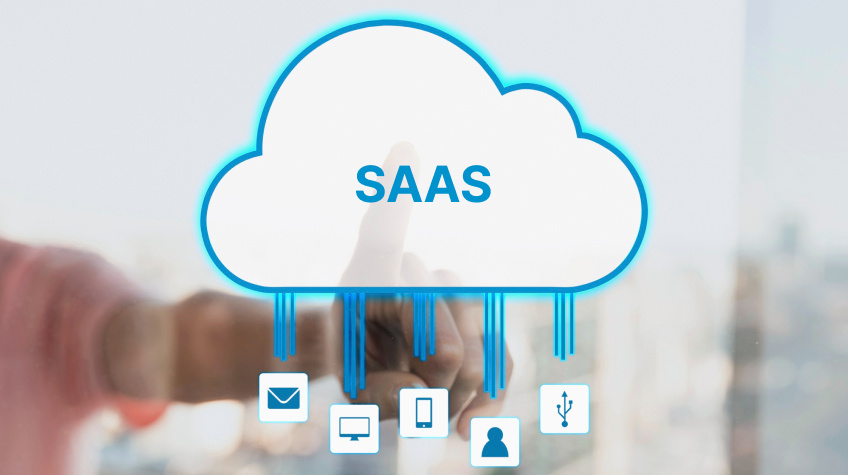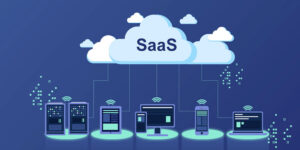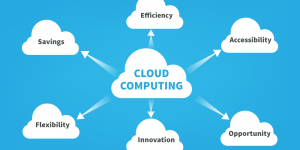
Cloud computing has emerged as a technological game-changer, reshaping how businesses operate and deliver services. This innovative paradigm offers various service models tailored to address distinct needs. Infrastructure as a Service (IaaS) provides the foundational building blocks, while Platform as a Service (PaaS) offers a comprehensive development platform.
Nevertheless, Software as a Service (SaaS) stands at the forefront of this transformation. SaaS represents more than a software delivery model; it embodies a shift towards user-centric, hassle-free solutions.
This model has gained unparalleled significance in modern businesses by offering on-demand access to applications, thereby reducing the need for complicated installations and updates. This introduction sets the stage for exploring the world of SaaS, where convenience, accessibility, and efficiency intersect to empower enterprises in unprecedented ways.
What is Saas?
Software as a Service (SaaS) is a revolutionary cloud computing model that redefines how Software is accessed, utilized, and maintained. The SaaS model eliminates the requirement for users to install and manage applications on their devices individually. Instead, applications are hosted in the cloud and available to users online. This approach offers unparalleled convenience, as any device with an internet connection can access the Software.
SaaS providers take on the responsibilities of maintenance, updates, security, and scalability, freeing businesses and individuals from the intricacies of technical management. From collaborative tools to customer relationship management systems, SaaS spans various applications, streamlining operations, enhancing collaboration, and enabling innovation with an agile, cost-effective solution.
History of Saas
The roots of Software as a Service (SaaS) trace back to the 1960s concept of timesharing, where multiple users shared access to a single computer. However, as we know it today, SaaS gained momentum in the late 1990s and early 2000s with the growth of the internet. Salesforce, founded in 1999, is a notable pioneer in introducing cloud-based CRM.
This paved the way for other SaaS giants like Google Apps (now Google Workspace) and Microsoft 365. The model’s cost-efficiency, scalability, and accessibility drove its adoption. Over the years, SaaS has transformed business software delivery, fostering innovation and shifting focus from software ownership to user experience and outcomes.
How does SaaS work?
Software as a Service (SaaS) operates by delivering applications remotely over the internet. Third-party providers host and maintain Software in their data centers. Users don’t need to install the Software locally; they access it through a web browser.
This cloud-based approach presents many benefits, including automatic updates, scalability, and accessibility from various devices. Users pay a subscription fee to access and use the Software, while the SaaS provider handles maintenance, security, and infrastructure management. This user-centric approach simplifies software management, enabling businesses to focus on leveraging the application’s functionalities to enhance productivity and efficiency.
Advantages of SaaS in Cloud Computing
1. Cost-Effectiveness
One of the standout advantages of SaaS within cloud computing is its inherent cost-effectiveness. SaaS introduces a financially efficient approach by eradicating the necessity for upfront investments in hardware and Software, along with the burden of ongoing maintenance expenses. Instead of capital-intensive outlays, businesses adopt a pay-as-you-go subscription model, offering budget predictability.
This empowers organizations, especially smaller ones, to access cutting-edge Software without enduring steep initial costs. Moreover, the responsibility for maintenance transfers to the provider, reducing operational complexities and unlocking valuable resources for strategic growth endeavors. SaaS truly reshapes the economics of software utilization, fostering agility and innovation.
2. Accessibility and Mobility
A compelling advantage of SaaS in cloud computing is its remarkable accessibility and mobility. This dynamic feature allows users to effortlessly reach SaaS applications through any device linked to the internet. This transcends geographical limitations, facilitating seamless work even from remote locales.
Notably, this accessibility bolsters collaboration among teams scattered across different geographic areas. The capacity to interact and contribute collectively, regardless of physical location, generates a significant competitive edge. SaaS transforms the workspace into a borderless environment where innovation and productivity thrive through unencumbered connectivity and real-time engagement.
3. Scalability
Scalability stands as a standout benefit of SaaS in cloud computing. The innate capability of SaaS applications to swiftly adjust in response to user demands ensures resource alignment with exact requirements. This prevents the inefficiencies of underutilization or the wastage associated with overprovisioning.
With SaaS, businesses are equipped to seamlessly expand their software usage as their operations grow, sidestepping the limitations of traditional software installations. This adaptable model proves pivotal in maintaining cost efficiency while accommodating fluctuations in workload. Whether upscaling during peak periods or downsizing during lulls, SaaS provides a dynamic and cost-effective solution that parallels business dynamics with optimal precision.
4. Automatic Updates and Maintenance
Automatic Updates and Maintenance is a defining advantage of SaaS within cloud computing. Here, SaaS providers seamlessly shoulder the responsibilities of software upkeep, encompassing updates, security fixes, and overall maintenance. This dynamic approach ensures users continually access the latest features and fortified security measures without needing manual intervention.
The burden of monitoring and managing these critical aspects is alleviated, freeing businesses to concentrate on core operations. This proactive framework guarantees that the software ecosystem remains current, optimized, and resilient, assuring users of a seamless, secure, and consistently enhanced experience.
5. Time-to-Value
The concept of Time-to-Value is a distinct advantage within SaaS and cloud computing. Swift deployment of SaaS applications expedites the journey from acquisition to utilization, significantly shortening the interval before reaping benefits. This rapid implementation is instrumental in accelerating time-to-market for novel projects and ventures.
SaaS cuts through these complexities, unlike traditional software setups that demand time-consuming installations and configurations. By streamlining deployment, businesses can promptly integrate innovative tools into their operations, gaining a competitive edge by swiftly translating ideas into tangible outcomes. SaaS’s efficiency in reducing setup timelines amplifies agility and responsiveness in a fast-paced business landscape.
6. Collaboration
Collaboration emerges as a potent advantage within SaaS and cloud computing. These platforms frequently incorporate native collaborative functionalities, facilitating real-time engagement among multiple users on shared projects or documents. The ability to collectively contribute, edit, and exchange insights in the same virtual space amplifies teamwork’s efficiency.
This seamless coaction transcends geographical boundaries, empowering teams dispersed across the globe. Unlike conventional methods, where document versions can fragment collaboration, SaaS ensures all participants are on the same page. This dynamic nurtures synergy and innovation, forging an environment where collective expertise converges effortlessly toward common objectives, irrespective of physical location.
7. SaaS Security
Security Measures are a paramount advantage within SaaS and cloud computing. Respected SaaS providers institute fortified security protocols, incorporating data encryption, stringent authentication mechanisms, and certifications attesting to regulatory compliance. These layers of protection collectively bolster data security, instilling confidence in users that sensitive information remains shielded from unauthorized access or breaches.
The commitment to safeguarding critical data underscores the significance of SaaS as a secure solution for businesses’ digital assets. Such proactive security frameworks ultimately enhance overall data protection, elevating SaaS as a trustworthy choice amidst the evolving cybersecurity landscape.
Also See: 7 Things To Consider Before Launching a SaaS Subscription Business
8. Global Accessibility
Global Accessibility stands as a prominent advantage of SaaS in the context of cloud computing. By dismantling geographical constraints, SaaS empowers users worldwide to seamlessly connect with shared applications and data, transcending the limitations of physical presence. This transformative capacity facilitates frictionless collaboration, enabling teams spanning different continents to collaborate as effortlessly as they were in the same room.
The eradication of distance-related obstacles fosters more inclusive teamwork and expedites decision-making and project progression. SaaS’s borderless access epitomizes the interconnected nature of the modern business landscape, enriching collaboration, innovation, and efficiency.
9. Reduced IT Burden
The advantage of Reduced IT Burden is a cornerstone of SaaS in cloud computing. This model significantly lightens the load on internal IT teams by shifting essential tasks—ranging from provisioning hardware to managing software updates—to the capable shoulders of the provider.
This delegation liberates valuable IT resources, enabling them to channel their expertise towards strategic, innovation-driven initiatives rather than being mired in mundane maintenance. Consequently, businesses can harness their IT talents to foster growth, enhance efficiency, and adapt swiftly to technological advancements. SaaS’s capability to streamline operations empowers organizations to optimize their IT talents and elevate overall performance.
10. User Experience
User Experience (UX) is a pivotal advantage of SaaS in cloud computing. Crafted with users at the forefront, SaaS applications boast intuitive interfaces and features that demand minimal training. This user-centric approach ushers in a seamless and engaging experience, eliminating complexities and hurdles often accompanying traditional Software.
Users can swiftly navigate the software landscape, harnessing its functionalities effortlessly. By focusing on enhancing usability, SaaS transforms even intricate tools into accessible assets. This heightened user-friendliness amplifies efficiency, reduces onboarding time, and cultivates a productive environment where individuals can harness technology’s power with ease and confidence.
11. Disaster Recovery and Backup
Disaster Recovery and Backup form a pivotal advantage within SaaS in cloud computing. SaaS providers frequently integrate robust data backup and disaster recovery mechanisms, safeguarding data integrity and accessibility even in unforeseen circumstances. This proactive approach assures users that their critical information remains shielded from loss or compromise.
Businesses mitigate data loss risks due to hardware failures, cyberattacks, or natural disasters by entrusting these critical components to SaaS providers. This robust safety net guarantees business continuity, enabling organizations to focus on core operations without anxiety over data security or unforeseen disruptions.
12. Environmentally Friendly
The ecological benefit of SaaS in cloud computing lies in its environmentally conscious approach. By diminishing reliance on physical infrastructure, SaaS effectively curbs energy consumption and reduces electronic waste. Unlike traditional software models, which necessitate extensive hardware setups, SaaS thrives in virtual environments, minimizing the demand for energy-hungry data centers. This leaner footprint translates into a reduced carbon impact.
Moreover, as SaaS streamlines scalability, resource allocation aligns precisely with direction, minimizing wastage. This conscientious framework underscores SaaS’s role in contributing to sustainability, making it an ally in pursuing greener technology practices and a more environmentally harmonious future.
Characteristics of SaaS in Cloud Computing
- Multi-Tenancy: SaaS serves multiple customers ( tenants) using shared infrastructure, maximizing resource utilization and reducing costs.
- Accessibility: SaaS applications can be accessed anywhere with a web connection, enabling remote work and collaboration.
- Automatic Updates: SaaS providers manage software updates centrally, so users can always access the latest security patches and features.
- Subscription Model: Users pay for SaaS on a subscription basis, often monthly or annually, promoting predictable costs.
- Scalability: Cloud applications can be effortlessly scaled up or down to accommodate changes in user demand.
- Managed Infrastructure: SaaS providers handle server provisioning, maintenance, and infrastructure management, relieving users of technical burdens.
- Pay-as-You-Go: Users only pay for the resources they consume, enhancing cost-effectiveness and avoiding over-provisioning.
- Shared Resources: SaaS applications share resources across multiple users, optimizing utilization and reducing waste.
- Compatibility: SaaS applications often offer integration options, allowing seamless connection with other software systems.
- Reduced Installation: Users do not need to install or maintain Software locally, minimizing deployment complexities.
- Device Agnostic: SaaS applications can be accessed from different instruments, including laptops, tablets, and mobile phones.
- Collaboration: SaaS often features real-time collaboration tools, facilitating user teamwork across different locations.
- Security Measures: Reputable SaaS providers implement robust security measures to safeguard data and user privacy.
- Centralized Management: Administrators can centrally manage user access, permissions, and configurations.
- Vendor Management: SaaS providers handle vendor-related tasks, allowing businesses to focus on core activities.
These characteristics collectively define SaaS in cloud computing.
Saas in Cloud Computing Example
- Salesforce: A pioneering SaaS application in customer relationship management (CRM), offering tools for sales, marketing, and customer support.
- Google Workspace (formerly G Suite): A suite of productivity tools, including Gmail, Google Docs, Sheets, Slides, and Drive, fostering collaboration and communication.
- Microsoft 365: A comprehensive SaaS solution combining productivity tools like Word, Excel, and PowerPoint with collaboration features like Teams and OneDrive.
- Zendesk: A SaaS platform for customer support, offering features such as ticketing systems, live chat, and knowledge bases.
These examples showcase how SaaS applications cater to specific business needs, enhancing efficiency, collaboration, and customer engagement.
In conclusion, Software as a Service (SaaS) has revolutionized the landscape of cloud computing by offering businesses and individuals a streamlined, cost-effective, and user-friendly approach to software utilization. This paradigm shift, exemplified by platforms like Salesforce, Google Workspace, and Microsoft 365, has redefined accessibility, scalability, and collaboration. SaaS’s ability to handle updates, security, and infrastructure management underscores its commitment to user convenience and data integrity.
As SaaS in cloud computing continues to shape the digital ecosystem, its impact on efficiency, innovation, and global connectivity remains an essential driving force in the modern business era.






